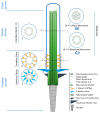Cilia Distal Domain: Diversity in Evolutionarily Conserved Structures
- PMID: 30769894
- PMCID: PMC6406257
- DOI: 10.3390/cells8020160
Cilia Distal Domain: Diversity in Evolutionarily Conserved Structures
Abstract
Eukaryotic cilia are microtubule-based organelles that protrude from the cell surface to fulfill sensory and motility functions. Their basic structure consists of an axoneme templated by a centriole/basal body. Striking differences in ciliary ultra-structures can be found at the ciliary base, the axoneme and the tip, not only throughout the eukaryotic tree of life, but within a single organism. Defects in cilia biogenesis and function are at the origin of human ciliopathies. This structural/functional diversity and its relationship with the etiology of these diseases is poorly understood. Some of the important events in cilia function occur at their distal domain, including cilia assembly/disassembly, IFT (intraflagellar transport) complexes' remodeling, and signal detection/transduction. How axonemal microtubules end at this domain varies with distinct cilia types, originating different tip architectures. Additionally, they show a high degree of dynamic behavior and are able to respond to different stimuli. The existence of microtubule-capping structures (caps) in certain types of cilia contributes to this diversity. It has been proposed that caps play a role in axoneme length control and stabilization, but their roles are still poorly understood. Here, we review the current knowledge on cilia structure diversity with a focus on the cilia distal domain and caps and discuss how they affect cilia structure and function.
Keywords: cilia; cilia distal domain; cilia structural diversity; microtubule-capping structures.
Conflict of interest statement
The authors declare no conflicts of interest.
Figures





Similar articles
-
Tetrahymena Cilia Cap is Built in a Multi-step Process: A Study by Atomic Force Microscopy.Protist. 2017 Dec;168(6):697-717. doi: 10.1016/j.protis.2017.10.001. Epub 2017 Oct 20. Protist. 2017. PMID: 29149699
-
The ciliary cytoskeleton.Compr Physiol. 2012 Jan;2(1):779-803. doi: 10.1002/cphy.c110043. Compr Physiol. 2012. PMID: 23728985 Review.
-
Drosophila transition fibers are essential for IFT-dependent ciliary elongation but not basal body docking and ciliary budding.Curr Biol. 2023 Feb 27;33(4):727-736.e6. doi: 10.1016/j.cub.2022.12.046. Epub 2023 Jan 19. Curr Biol. 2023. PMID: 36669498
-
Microtubule-associated proteins and emerging links to primary cilium structure, assembly, maintenance, and disassembly.FEBS J. 2021 Feb;288(3):786-798. doi: 10.1111/febs.15473. Epub 2020 Jul 27. FEBS J. 2021. PMID: 32627332
-
Axonemal microtubule dynamics in the assembly and disassembly of cilia.Biochem Soc Trans. 2025 Jan 31;53(1):101-11. doi: 10.1042/BST20240688. Biochem Soc Trans. 2025. PMID: 39889304 Free PMC article. Review.
Cited by
-
Kinesin-8B controls basal body function and flagellum formation and is key to malaria transmission.Life Sci Alliance. 2019 Aug 13;2(4):e201900488. doi: 10.26508/lsa.201900488. Print 2019 Aug. Life Sci Alliance. 2019. PMID: 31409625 Free PMC article.
-
Ciliary Proteins: Filling the Gaps. Recent Advances in Deciphering the Protein Composition of Motile Ciliary Complexes.Cells. 2019 Jul 17;8(7):730. doi: 10.3390/cells8070730. Cells. 2019. PMID: 31319499 Free PMC article. Review.
-
In vivo imaging shows continued association of several IFT-A, IFT-B and dynein complexes while IFT trains U-turn at the tip.J Cell Sci. 2021 Sep 15;134(18):jcs259010. doi: 10.1242/jcs.259010. Epub 2021 Sep 23. J Cell Sci. 2021. PMID: 34415027 Free PMC article.
-
SUB-Immunogold-SEM reveals nanoscale distribution of submembranous epitopes.Res Sq [Preprint]. 2024 Jan 22:rs.3.rs-3876898. doi: 10.21203/rs.3.rs-3876898/v1. Res Sq. 2024. Update in: Nat Commun. 2024 Sep 10;15(1):7864. doi: 10.1038/s41467-024-51849-x. PMID: 38343799 Free PMC article. Updated. Preprint.
-
Tekt3 Safeguards Proper Functions and Morphology of Neuromast Hair Bundles.Int J Mol Sci. 2025 Mar 28;26(7):3115. doi: 10.3390/ijms26073115. Int J Mol Sci. 2025. PMID: 40243732 Free PMC article.
References
-
- Dellinger O.P. The cilium as a key to the structure of contractile protoplasm. J. Morphol. 1909;20:171–210. doi: 10.1002/jmor.1050200202. - DOI
-
- Schmitt F.O., Hall C.E., Jakus M.A. The Ultrastructure of Protoplasmic Fibrils. Biol. Symp. 1943;10:261–276.
Publication types
MeSH terms
LinkOut - more resources
Full Text Sources
Miscellaneous

